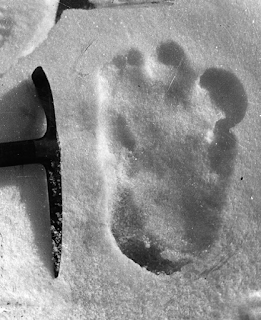In 1921 Lt. Colonel Charles Kenneth Howard-Bury, a British soldier leading an expedition up Mount Everest, recounted a puzzling story. His team had been scaling the mountain’s north face when they noticed dark shapes moving about in the snow above them. By the time the explorers reached the site, the only signs of life were large, unusual, human-like footprints. Howard-Bury said his Sherpa guides called this creature the ‘Metoh- Kangmi’. Translated, this became the ‘Abominable Snowman’.
In fact, ‘Metoh-Kangmi’ was a collective term for any of three mythical mountain creatures. Individually, they had their own names – the ‘Dzu Teh’, a large, hairy beast which experts believe is actually one of the rare bear species in the region, ‘Thelma’, which is regarded as being a species of gibbon, and the ‘Meh-Teh’ or ‘Yeh-Teh’, the ‘man-beast’ or ‘rock dweller’. This final animal is the most enigmatic. It is described as being between five and six feet tall, with reddish hair, long hanging arms, a conical, pointed head and a human face. This ‘Yeh- Teh’ is what we now know as the Yeti.
In 1925 a Greek photographer called N. A. Tombazi was on expedition in the Himalayas when one of his Sherpa guides pointed at a figure in the distance. Tombazi said the creature stood upright, just like a human, and was pulling at some rhododendron bushes. The beast disappeared before Tombazi could capture it on film, but the party headed over to the area where it had been viewed and found footprints strangely similar to human feet. During the following years, there were many reports of odd tracks in the snow.
In 1951 the eminent mountaineers, Eric Shipton and Michael Ward, were part of the Everest Reconnaissance Expedition. They were trying to plot the best route up the mountain when they came upon a set of fresh, unusual footprints. Shipton and Ward took photographs of the 13 by 18-inch prints, and followed the trail before it eventually disappeared. Sir Edmund Hillary and Sherpa Tenzing Norgay, the two most celebrated visitors to Everest, actually found giant footprints on their way to the summit in 1953. This was particularly interesting because Norgay’s father was supposed to
have encountered a Yeti shortly before he died, whereas Hillary would later lead an effort to find evidence of the Yeti’s existence.
When Hillary’s 1960 Yeti expedition found nothing, the great man stated that the beast was nothing more than a fairy tale. But many experts felt Hillary had rather rushed to his conclusions. Even Hillary’s colleague on the mission, Desmond Doig, said the expedition had been too bulky and clumsy. Doig agreed that they had not encountered a Yeti, but neither had they seen a snow leopard, which undoubtedly exists.
This failed expedition killed off much interest in the Yeti, but over the years more unusual footprints were found. In 1974 one of the creatures reportedly attacked a Sherpa girl and her yaks, killing a couple of her animals. Then, in March 1986, Tony Woodbridge, a British physicist doing a sponsored solo run around the Himalayas, had a remarkable face-to-face meeting with the monster. Woodbridge had seen tracks earlier in the day, but thought no more about it until he heard a crashing sound like an
avalanche.
Further up the trail, snow had indeed fallen, creating a giant impenetrable frozen wall. Strangely, it looked as if something had slid down the snow. Woodbridge followed prints at the bottom of the mound, and 150 metres away he spotted a large, hairy, powerfully built creature standing stockstill. The beast did not move an inch, and Woodbridge was lucky enough to have his camera on him. Unfortunately, despite Woodbridge’s initial strong convictions, close examinations of his photographs
instilled some doubt and a return to the area convinced Woodbridge that he had only encountered a tree stump.
Even if episodes like this do nothing to convince sceptics, many experts agree that the idea of an unknown species of ape is not so far-fetched. Some species of wild cattle and jungle deer have only been discovered in the last ten years. It is possible that Yeti-like creatures, descended from prehistoric apes could be roaming parts of the world completely undiscovered. Whatever the scientists and experts prove, Sherpas have already accepted the belief that up in their mountains they are not alone.
source : 100 Strangest Mystery





.JPG)



0 comments:
Post a Comment